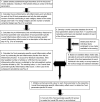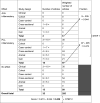Designing and developing a literature-derived, population-based dietary inflammatory index
- PMID: 23941862
- PMCID: PMC3925198
- DOI: 10.1017/S1368980013002115
Designing and developing a literature-derived, population-based dietary inflammatory index
Abstract
Objective: To design and develop a literature-derived, population-based dietary inflammatory index (DII) to compare diverse populations on the inflammatory potential of their diets.
Design: Peer-reviewed primary research articles published through December 2010 on the effect of diet on inflammation were screened for possible inclusion in the DII scoring algorithm. Qualifying articles were scored according to whether each dietary parameter increased (+1), decreased (-1) or had no (0) effect on six inflammatory biomarkers: IL-1β, IL-4, IL-6, IL-10, TNF-α and C-reactive protein.
Setting: The Dietary Inflammatory Index Development Study was conducted in the Cancer Prevention and Control Program of the University of South Carolina in Columbia, SC, USA from 2011 to 2012.
Results: A total of ≈6500 articles published through December 2010 on the effect of dietary parameters on the six inflammatory markers were screened for inclusion in the DII scoring algorithm. Eleven food consumption data sets from countries around the world were identified that allowed individuals' intakes to be expressed relative to the range of intakes of the forty-five food parameters observed across these diverse populations. Qualifying articles (n 1943) were read and scored based on the forty-five pro- and anti-inflammatory food parameters identified in the search. When fit to this composite global database, the DII score of the maximally pro-inflammatory diet was +7·98, the maximally anti-inflammatory DII score was -8·87 and the median was +0·23.
Conclusions: The DII reflects both a robust literature base and standardization of individual intakes to global referent values. The success of this first-of-a-kind attempt at relating intakes of inflammation-modulating foods relative to global norms sets the stage for use of the DII in a wide variety of epidemiological and clinical studies.
Figures


References
-
- Pearson TA, Mensah GA, Alexander RW et al. (2003) Markers of inflammation and cardiovascular disease: application to clinical and public health practice: a statement for healthcare professionals from the Centers for Disease Control and Prevention and the American Heart Association. Circulation 107, 499–511. - PubMed
-
- Keibel A, Singh V & Sharma MC (2009) Inflammation, microenvironment, and the immune system in cancer progression. Curr Pharm Des 15, 1949–1955. - PubMed
-
- Terzic J, Grivennikov S, Karin E et al. (2010) Inflammation and colon cancer. Gastroenterology 138, 2101–2114. - PubMed
-
- Wium-Andersen MK, Orsted DD, Nielsen SF et al. (2013) Elevated C-reactive protein levels, psychological distress, and depression in 73,131 individuals. JAMA Psychiatry 70, 176–184. - PubMed
Publication types
MeSH terms
Substances
Grants and funding
LinkOut - more resources
Full Text Sources
Other Literature Sources
Medical
Research Materials

